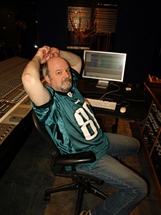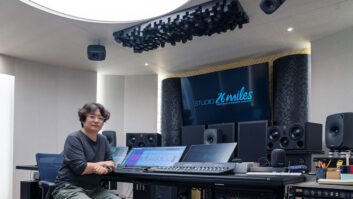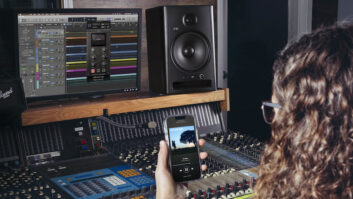
Small to mid-sized studios may be springing up all over the map, but that doesn’t mean they can do everything the “big guys” can do. In many cases, the little guys can only take a project so far before having to collaborate with a larger commercial studio to finish it. The question is, though, what factors dictate when the owner of a small studio should work in conjunction with a commercial studio? And how can small and large studios work together effectively? Below, we share the experiences of several engineers and explore how they have achieved success by partnering with other studios and learned to recognize and avoid common and potentially dangerous pitfalls.
Tom McCauley
When to Call in the Big Boys
There’s no question that thriftiness is calling most of the shots these days, which is one of the reasons project studios and smaller rooms are becoming increasingly busy. However, there are times when a big room is simply a must. “Nowadays, budgets usually don’t allow for the price tag associated with a commercial studio, but I have worked on a number of projects that I knew would be better served if a larger studio were involved in some way,” says Tom McCauley, whose home studio, Mixworks, has been around for more than two decades. “Sometimes, there’s just no getting around it. For example, a project may benefit from a large console, a hefty mic collection, or a variety of instrument and equipment choices, and the larger spaces are the ones that offer these options.” This was the case for McCauley during a recent project where a singer/songwriter project required a very specific type of piano for a particular song. The commercial studio McCauley recommended offered multiple choices, and they were able to identify just the right one for the project. If they had decided to record at McCauley’s studio, then that obviously would not have been the case.
Physical space requirements are also a determining factor. If tracking involves a string section or an ensemble or large group of musicians that must play together at the same time, a larger commercial space is the best option. For the project referenced above, one of the requirements was that the entire rhythm section would be able to play together at the same time, and the commercial space McCauley recorded in gave the group the flexibility they needed.
Side 3 Studios
Beyond space, itself, the acoustic environment of a facility can be a critical element in determining a project’s success. “I could set up high-quality Neumann mics in a home studio and the sound would be okay, but the reality is, what I get is not going to sound the same as it does in an acoustically treated space that has been specifically created to record music,” says Adelio Lombardi, owner/CEO of Side3 Studios (Denver, Colo.), as well as the owner of a high-end home studio. “In many cases, acoustics are not considered when a home studio is being built, even though they play such a significant part in the recording process.” For some projects, this is not a major issue, but when sonic quality is going to be judged critically, it is.
Of course, not all home/project studios are alike. McCauley says he has the occasional client who is wealthy enough to build a great home studio that is the “real deal,” but these studios are normally not open to the public; he often works with bass player Brian Bromberg at his home studio, which can accommodate fairly substantial recording. Lombardi, himself, built a home studio that rivals some smaller commercial spaces. Having said that, this is certainly the exception and not the rule for personal facilities.
Ellis Sorkin
Big and Small Unite
The good news is that it is becoming more common for small and large studios to work collectively, which is providing more opportunity for success. For instance, Ellis Sorkin, founder of the Studio Referral Service (L.A.), will often recommend a mixture of large commercial studios for tracking and a smaller studio for mixing and overdubbing. “This type of situation happens quite often because of budgets,” says Sorkin, who started SRS in 1980. “In fact, I recently hooked up a band with Capitol Records and then a residential studio for the overdubs,” he explains.
That scenario is familiar to McCauley, who recognizes the limitations of his home studio. “I don’t rely on my space to do a lot of recording,” he says. “However, I have a nice rig and am able to do a majority of editing and premix stuff at home, which winds up working out really well.” McCauley says it’s rare that clients actually want to be present for the mix nowadays, so not only can he take his time without the pressure of a client breathing down his neck, but the process is free of distractions, which amps up his productivity.
Side3 also coordinates with other studios regularly, but in unique ways. While the studio accommodates recording artists and enjoys a healthy amount of recording projects, a majority of the studio’s mix work is typically accomplished without the client ever setting foot in the facility. “We often receive stems that were generated by outside sources that are sent to us to mix, or we produce sessions in other studios via phone or Internet,” explains Lombardi. This is often the case for projects involving well-known DJ Frank E, (Lil Wayne, Kanye West, Flo Rida, Madonna, etc.), who is one of the producers signed to Lombardi’s management company. Typically, his projects involve multiple sources. Take into consideration the path of a recent Chris Brown track in which Frank E was involved: Frank E began working with talented, up and coming producer J Quintel to produce the skeleton of a track using Fl Studio, which is the program that Quintel uses. The track was then exported so Frank E could further produce it in Ableton Live, and then the finishing touches were added in Pro Tools. After that, the song was pitched to Chris Brown, who wound up writing to it, and then recorded the vocals at a studio in L.A.
John Cuniberti
Though the specifics may vary, that lengthy chain is much the same for San Francisco Bay Area mixing/mastering engineer John Cuniberti,
who has worked with such clients as Chickenfoot (Sammy Hagar, Michael
Anthony, Chad Smith and Joe Satriani), Aerosmith and the Neville
Brothers, among many others. However, for Cuniberti, the process
typically involves more personal contact with clients and juggling of
studios. For a recent project focusing on a singing duo, for instance,
multiple steps were involved. First, Cuniberti brought the duo named
Yep! into a rehearsal facility where they could work on material and
make informal recordings. Once the arrangements were worked out,
Cuniberti brought the group to Fantasy Studios, a large facility in
Berkeley, Calif. Fantasy offers large rooms and consoles, and has the
space available to record multiple musicians at once. Cuniberti spent
five days there tracking the band. He then went back to his home
studio, sifted through all of the tracks and edited the material. In
his home studio, Cuniberti brought the singers and musicians in to
record vocals, along with acoustic guitars. “I felt like my home could
effectively accommodate this portion of the project, because my living
room has nice acoustics and I use a simple high-end signal path of
Telefunken mics as well as D.W. Fearn and Great River mic preamps,” he
explains. “However, each of the other places we used was a necessity.”
The physical spaces, of course, are not the only consideration. There
are also the different files and platforms that engineers have to
consider. Fortunately, in most cases, the engineers we talked to have
not run into significant problems in terms of file sharing. “The
biggest problem we run into when it comes to file-sharing is the fact
that every DAW handles audio differently, which often affects the speed
and ease of transfers,” says Lombardi.
Adelio Lombardi of Side 3 Studios in Denver, Colo.
Maneuvering Through Pitfalls
One of the most common issues
that engineers find themselves dealing with is operating effectively
and comfortably in unfamiliar studios, because they are at the mercy of
the setup. When it comes to working in a project studio, this means
coming prepared with additional equipment, just in case. McCauley says
he has had to spend hours just tweaking the room so that he could
actually begin working.
However, a significant landmine that engineers find themselves trying
to avoid is agreeing to mix or master projects that were not recorded
properly because of low-quality equipment or user error. “If I receive
a project and it’s such a mess that I know I’ll have to spend two days
of my life just organizing and going through every track, I turn the
project down,” says Cuniberti, who speaks from experience. One of his
remedies is a questionnaire that he sends out to potential clients. The
15 questions included on the questionnaire usually provide him with
enough information about whether he wants to take on the job or not.
“The problem often is that a project has been recorded and produced by
an amateur, but now the band or artist decides to hire a professional
to do the mastering. It’s a fantasy to believe that someone is going to
magically undo all the mistakes made in the previous steps of the
process,” he says.
McCauley agrees. “My philosophy is, if I have to do more fixing than
mixing, I don’t want to deal with it,” he says. “Unfortunately, a guy
may be a great musician, but he may know nothing about engineering, yet
he will take it upon himself to act as engineer on a project. By the
time he sends me the tracks, they’re virtually unusable because the
right equipment wasn’t used or the track is blatantly distorted.”
Cuniberti’s concern is that in these cases, a client will expect that
he’s able to make the project sound 50 percent better in mastering,
when in actuality, he’ll only be able to make it sound 5 percent
better. “At the end of the day, the client will wind up being unhappy,
which makes me unhappy, so the bottom line is, if I can’t provide the
client a good-sounding master, I will, in some cases, ask for a remix
or I simply won’t take it on.”
Studio Unknown is full-service audio post-production facility and
recording studio that specializes in helping clients discover creative
sound for film, video, Web, gaming, and artist projects. For more
information, visit www.studiounknown.com.







